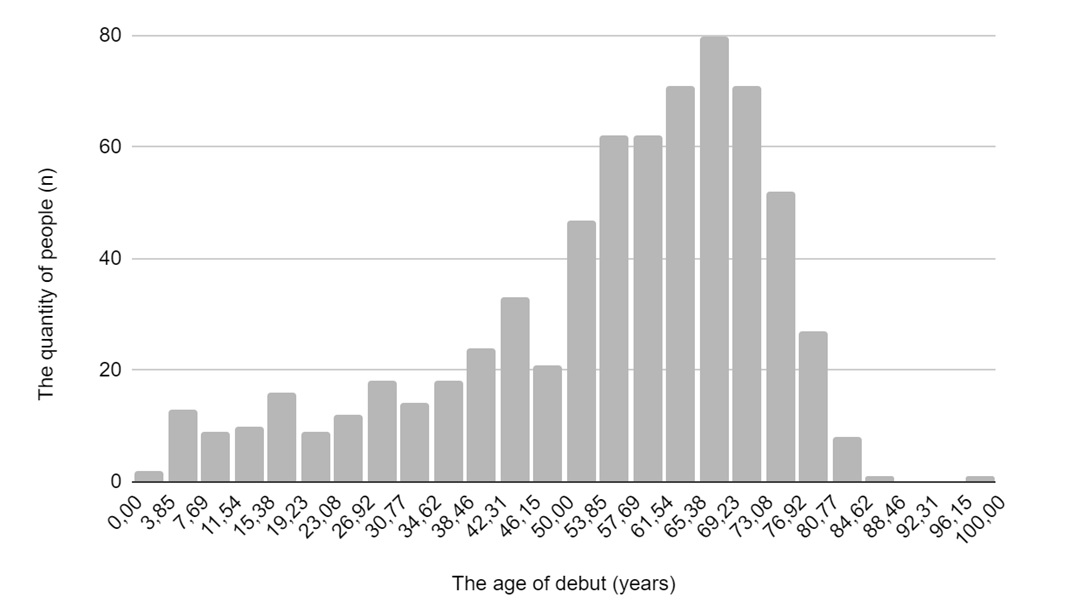Category: Tremor
Objective: ET is the most diagnosed movement disorder, the frequency of which increases as a person ages.
Background: To examine the incidence of social phobia, anxiety and depression in patients with essential tremor (ET)
Method: 681 patients with ET from 2010 to 2022 were interviewed: males 187 (27.5%) and females 494 (72.5%), average age was 66±14 years. The average duration of ET experience was 11 years. Distribution of patients by age of first symptoms debut is presented on figure1.
All patients were tested for anxiety and depression using the Hospital Anxiety and Depression Scale and the Spielberger-Hanin Anxiety Scale.
Results: 307 (45%) men with ET: 217 (71%) women, 90 (29%) men presented the complaint of tremor without signs of domestic maladaptation (no disturbance of eating, writing, etc.).
The number of patients with anxiety (severe + subclinical) was 174 (25.5%) people: 146 (21.4%) women, 28 (4.1%) men. However, the number of patients with depression (severe + subclinical) was 134 (19.6%) people: 111 (16.3%) women, 23 (3.4%) men.
After a treatment session where the nature of the tremor was explained and by mutual consent (doctor and patient), only 135 (19.8%) of 307 (45%) people without signs of domestic maladaptation: 85 (13%) women and 50 (7%) men did not receive recommendations for corrective treatment.
The remaining 546 (80.2%) individuals: 172 (25.3%) with tremor without domestic maladaptation, due to the presence of fear of being in the community and feeling uncomfortable, and 374 (54.9%) with signs of domestic maladaptation received recommendations for treatment.
Of the total sample, 304 (45 %) reported an increase in the current tremor of hands and heads due to stress: 238 (48%) women and 66 (35%) men. Among these 304 people with increased tremor on the background of emotional reactions with clinically expressed anxiety was – 66 (22%) people: 61(20%) women, 5 (2%) men, with clinically severe depression 36 (12%): 35 (12%) women, 1 (0.3%) men, and with a combination of anxiety and depression were – 31 (10%) people: 30 (10%) women, 1 (0.3%) men.
Conclusion: according to our study, 45% of people with ET had no signs of domestic maladaptation, 19.8% of people by mutual consent (doctor and patient) did not receive treatment due to lack of restrictions leading not only to domestic but also social maladaptation, 25.3% of people without signs of domestic maladaptation had signs of social phobia.
Distribution of patients by age of debut
To cite this abstract in AMA style:
S. Shtaimets, а. Shtraub, N. Zhukova, YU. Lalov, L. Tkachenko, I. Zhukova, A. Agasheva, D. Novotnyy. Social phobia, anxiety and depression in patients with essential tremor [abstract]. Mov Disord. 2024; 39 (suppl 1). https://www.mdsabstracts.org/abstract/social-phobia-anxiety-and-depression-in-patients-with-essential-tremor/. Accessed December 6, 2025.« Back to 2024 International Congress
MDS Abstracts - https://www.mdsabstracts.org/abstract/social-phobia-anxiety-and-depression-in-patients-with-essential-tremor/

